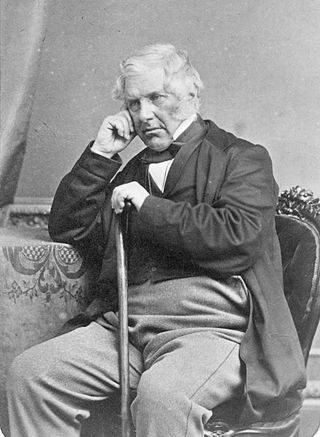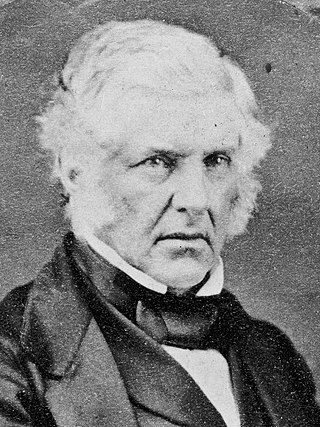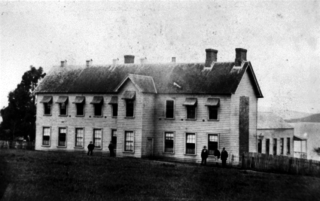
Sir Harry Albert Atkinson served as the tenth premier of New Zealand on four separate occasions in the late 19th century, and was Colonial Treasurer for a total of ten years. He was responsible for guiding the country during a time of economic depression, and was known as a cautious and prudent manager of government finances, though distrusted for some policies such as his 1882 National Insurance (welfare) scheme and leasehold land schemes. He also participated in the formation of voluntary military units to fight in the New Zealand Wars, and was noted for his strong belief in the need for seizure of Māori land.

Sir Edward William Stafford served as the third premier of New Zealand on three occasions in the mid 19th century. His total time in office is the longest of any leader without a political party. He is described as pragmatic, logical, and clear-sighted.

Sir Francis Dillon Bell was a New Zealand politician of the late 19th century. He served as New Zealand's third Minister of Finance, and later as its third Speaker of the House. The town of Bell Block near New Plymouth – on land Bell bought from the Puketapu iwi in 1849 – is named after him, as is Bell Street, Whanganui. Bell's son, Francis Henry Dillon Bell, became the first New Zealand born Prime Minister in 1925.

Henry Sewell was a prominent 19th-century New Zealand politician. He was a notable campaigner for New Zealand self-government, and is generally regarded as having been the country's first premier, having led the Sewell Ministry in 1856. He later served as Colonial Treasurer (1856–1859), as Attorney-General (1861–1862), and twice as Minister of Justice.
The 2nd New Zealand Parliament was a term of the Parliament of New Zealand. It opened on 15 April 1856, following New Zealand's 1855 election. It was dissolved on 5 November 1860 in preparation for 1860–61 election. The 2nd Parliament was the first under which New Zealand had responsible government, meaning that unlike previously, the Cabinet was chosen by Parliament rather than by the Governor-General of New Zealand.

Sir Frederick Whitaker was an English-born New Zealand politician who served twice as the premier of New Zealand and six times as Attorney-General.
The following lists events that happened during 1856 in New Zealand.

The Sewell Ministry was the first responsible government in New Zealand. Unlike previous executives, its members were held accountable to Parliament. This would form the basis for future governments in New Zealand.
The 3rd New Zealand Parliament was a term of the Parliament of New Zealand. Elections for this term were held between 12 December 1860 and 28 March 1861 in 43 electorates to elect 53 MPs. Two electorates were added to this during this term, Gold Fields District and a new Dunedin electorate created by splitting the existing City of Dunedin into Dunedin and Suburbs North and Dunedin and Suburbs South, increasing the number of MPs to 57. During the term of this Parliament, six Ministries were in power.

The Colony of New Zealand was a colony of the United Kingdom of Great Britain and Ireland that encompassed the islands of New Zealand from 1841 to 1907. The power of the British Government was vested in the governor of New Zealand. The colony had three successive capitals: Okiato in 1841; Auckland from 1841 to 1865; and Wellington from 1865, which continues as the capital of New Zealand today.
The First Stafford Ministry was the third responsible government to be formed in New Zealand, and the first to last more than a few weeks. It formed in June 1856, and lasted until July 1861. As the office of Premier had yet to be established, Edward Stafford served as head of the government, although initially Henry Sewell was the Minister who reported to the Governor.
The Domett Ministry was a responsible government which held power in New Zealand from August 1862 to October 1863. Although Alfred Domett was the head of the government, he was never appointed Premier as that office had yet to be established. Instead, he was Colonial Secretary and Secretary for Crown Lands.

The 1865 Town of New Plymouth by-election was a by-election held in the Town of New Plymouth electorate during the 3rd New Zealand Parliament, on 19 May 1865. The by-election was caused by the resignation of the incumbent, Charles Brown, and was won unopposed by Henry Sewell. Whilst Sewell was not a local resident, he was a member of the government through his appointment to the Legislative Council, the upper house of Parliament. Sewell accepted the invitation to represent the electorate, as him becoming a member of the lower house was seen to strengthen the government.

The General Assembly House, colloquially called "Shedifice" by the members of Parliament, was the first building to house the New Zealand Parliament in Auckland. It was in use by Parliament from 1854 until 1864 during the time that Auckland was the capital of New Zealand. It was also used by the Auckland Provincial Council, with Auckland Province owning the building from 1858. After the abolition of the provincial government system, the building was used by the government's survey department and was then used by Auckland University College. The General Assembly House was demolished in 1917 to make way for Anzac Avenue. Today, a reserve adjacent to Parliament Street called Parliament Reserve commemorates the location where the New Zealand Parliament met initially.
The Second Fox Ministry was a responsible government which held power in New Zealand from July 1861 to August 1862. Although William Fox was the head of the government, he was never appointed Premier as that office had yet to be established. Instead, he was Attorney-General and then Colonial Secretary.
The Whitaker-Fox Ministry was a responsible government which held power in New Zealand from October 1863 to November 1864. Although Frederick Whitaker was the head of the government, he was never appointed Premier as that office had yet to be established. Instead, he was Attorney-General sitting in the Legislative Council while William Fox led the Government in the lower house.
The Third Fox Ministry was a responsible government which held power in New Zealand from June 1869 to September 1872. Although William Fox was the head of the government, he was never appointed Premier as that office had yet to be established, although he did resign the office at the end of his tenure. The Ministry was also known as the Fox-Vogel Ministry as most of the agenda was set by the Treasurer, while Fox busied himself with administrative affairs and moral crusades such as the attempted introduction of local option polls for liquor licensing.
The First Vogel Ministry was a responsible government which held power in New Zealand from April 1873 to July 1875.
The Hall Ministry was a responsible government in New Zealand, sometimes referred to as part of the Continuous Ministry. It took office after defeating Sir George Grey's supporters in a confidence motion, and is usually regarded as a conservative Ministry, although Hall himself described his followers as "the independent Liberal party".













